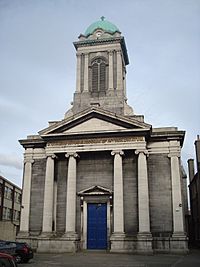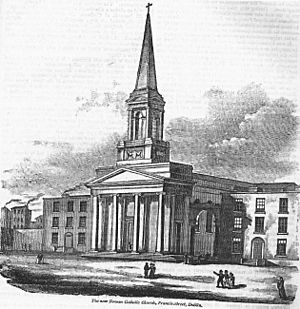Church of St Nicholas of Myra Without, (Roman Catholic) facts for kids
Quick facts for kids St. Nicholas of Myra (Without) |
|
|---|---|
| St. Nicholas of Myra (Without), Francis Street | |
 |
|
| 53°20′28″N 6°16′26″W / 53.341108°N 6.273888°W | |
| Location | Francis Street Dublin |
| Country | Ireland |
| Denomination | Roman Catholic |
| Website | francisstreetparish.ie |
| History | |
| Dedication | Saint Nicholas |
| Dedicated | 1835 |
| Architecture | |
| Architect(s) | John Lesson Patrick Byrne |
| Architectural type | Church |
| Style | Greek Revival |
| Groundbreaking | 1829 |
| Administration | |
| Parish | Francis Street Parish |
| Deanery | South City Centre |
| Archdiocese | Dublin |
The Church of St Nicholas of Myra (Without) is a historic Roman Catholic church located on Francis Street in Dublin, Ireland. People have worshipped on this spot for a very long time, even as far back as the 1100s! The church you see today was built in 1829 and officially opened in 1835. It's named after Saint Nicholas, a very famous saint.
Contents
A Long History of Worship
The land where the church stands has been a place of worship for centuries. Around the 1100s, there was a simple wooden chapel here. Later, this chapel was taken down.
The First Stone Church
In 1233, a group of monks called the Franciscans came to Ireland. They built a stone church and a monastery on this very spot. A man named John le Porter gave the land for free in 1235. Even King Henry III helped out, giving money for the building.
This first stone church was named after St. Francis of Assisi. This is how the nearby street, Francis Street, got its name! Sadly, this church was destroyed in the 1540s during a time when many monasteries were closed down.
Challenges and New Beginnings
Later, in the 1600s, the Franciscans tried to get the land back. However, their plans were stopped because of a big event called the "Popish Plot" in 1678. This was a time when there was a lot of fear and false accusations against Catholics.
The current church was built to be a very important church for Irish Catholic Archbishops. It replaced an older church that was located on Limerick Lane.
Building the Current Church
The building of the current church started in 1829. The first architect was John Leeson. The church opened its doors in 1834 and was officially dedicated in 1835.
In 1860, another architect named Patrick Byrne made some big changes to the church. He added many of the main features you see on the outside today. These include the grand entrance with columns (called an ionic portico), the triangular part above it (a pediment), the bell tower, and the small dome on top (a cupola).
Special Statues
At one time, there were three statues on the pediment above the main entrance. These statues showed Our Lady, Saint Patrick, and Saint Nicholas. The statue of Saint Nicholas had three golden balls at his feet, which are symbols of charity. It also had an anchor, which represents hope.


